One of the popular cosmetic procedures is peeling. It allows you to clean not only the surface of the skin, but also the deeper layers. Trichloroacetic acid is often used to remove dead particles of the epidermis, improve blood circulation and rejuvenate. The method has its own indications and contraindications, which should be familiarized with in advance.
What is peeling?
To keep your skin looking well-groomed and healthy, it is extremely important to organize proper care. One of the necessary and popular procedures is peeling, during which all dead cells and impurities are removed from the surface skin. Using conventional washing products (foams, scrubs, gels), it is impossible to achieve such an amazing result.
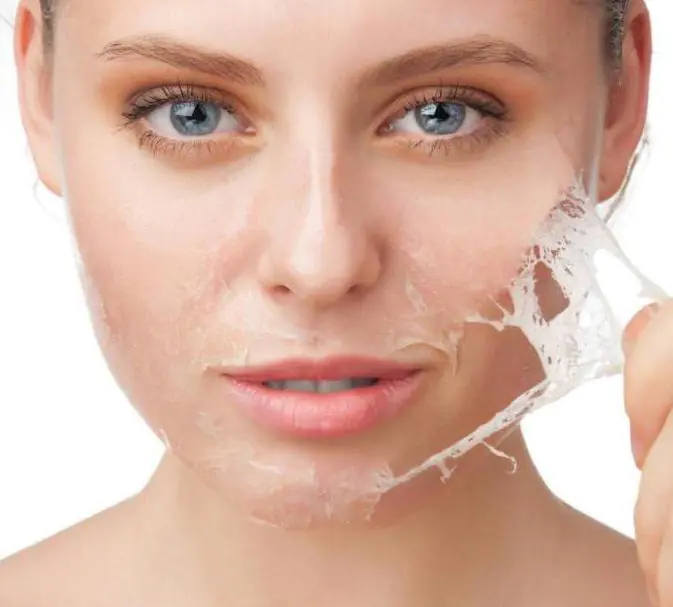
Cosmetic manipulation can also be carried out at home. In this case, natural non-aggressive components are usually used. This procedure helps maintain a healthy appearance of the skin on the face, but does not provide deep cleansing.
To eliminate cosmetic defects, you should resort to chemical peelings. It is recommended to carry out the procedure in a cosmetologist's office. The specialist will select the necessary components and their concentration for gentle cleansing of the facial skin.
Types of peeling
Many experts call peeling the secret of youth. The type of procedure is selected depending on the needs of the epidermis and age. Superficial peeling is suitable for all skin types. It allows you to eliminate dead skin cells and cleanse pores.
Medium peeling provides deeper cleansing. It is recommended to do it in the presence of age-related and pronounced facial wrinkles. After just one session, there will be a noticeable improvement in skin condition. The procedure is in great demand in beauty salons. Trichloroacetic acid is usually used as the active ingredient. The properties and mechanism of action of this substance will be described in detail below.
Deep peeling is a medical procedure and can only be performed by an experienced specialist. After such a procedure, the epidermis needs long-term recovery, proper nutrition and hydration. The cost of the procedure differs significantly from previous ones.
Trichloroacetic acid
TCA peeling is a cosmetic procedure that involves the use of trichloroacetic acid in varying concentrations. The active aggressive substance is organic and dissolves well in water. The composition of the component allows you to clean the middle layers of the epidermis.
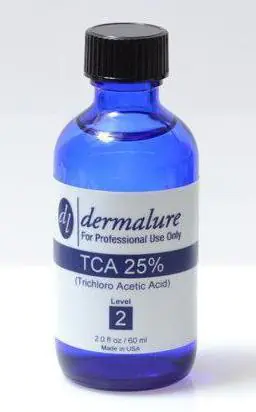
Trichloroacetic acid is used in cosmetology due to the presence of many beneficial properties:
- removes dead particles from the surface layer of the skin
- eliminates inflammation and kills pathogenic bacteria
- normalizes sebum production
- tightens pores
- stimulates metabolic processes, affecting blood capillaries
- eliminates pigmentation, whitens the skin.
Indications for use
Trichloroacetic acid peeling is not suitable for everyone. Feedback from experts indicates the need for mandatory consultation before the procedure. Cosmetologists say that chemical facial cleansing is necessary only if there are severe age-related skin problems.
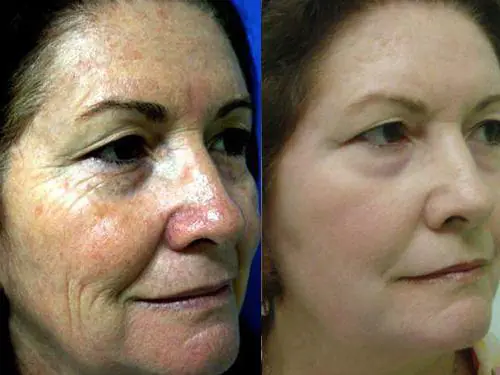
Indications for TCA peeling are:
- post-acne
- hyperkeratosis
- oily skin with enlarged pores and acne
- scars on the skin of the face
- strong pigmentation
- wrinkles as a result of photoaging
- loss of elasticity
- pitting on the skin after chickenpox
- expression lines in the eye area
- stretch marks.
How does it work?
Peeling with trichloroacetic acid can cope with almost any cosmetic defects of the epidermis. First of all, the chemical cleanses the top layer of the skin, leaving it smooth and silky. Pores are noticeably reduced and oily shine is eliminated.
The procedure can significantly lighten pigmented areas. The active component leads to exfoliation of dead skin particles on the top layer, where freckles form. The procedure is recommended to be carried out in the cold season to avoid the aggressive effects of ultraviolet radiation and the reappearance of stains.
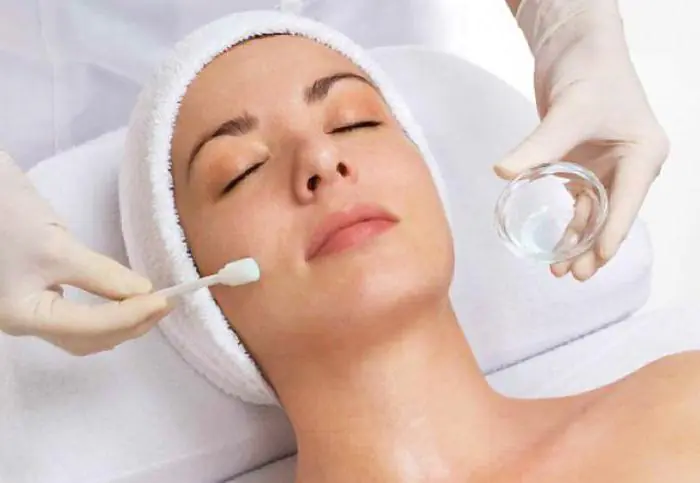
Trichloroacetic acid activates collagen production processes by dilating capillaries. This allows you to restore elasticity and firmness to the skin, eliminate wrinkles (facial and age-related).
Thanks to its antibacterial properties, the active substance fights well against inflammatory processes that occur in different layers of the epidermis.
Cleaning depth
For chemical cleansing of the skin, cosmetologists often use Skin Rebirth products. This Spanish company produces high-quality Easy TCA kits with different concentrations of the aggressive component.
A solution of trichloroacetic acid at 15% concentration has the most gentle effect. The product also contains fruit acids and saponins, which increase the penetrating ability of the active component. A weakly concentrated solution is used to exfoliate dead particles of the epidermis and improve appearance.
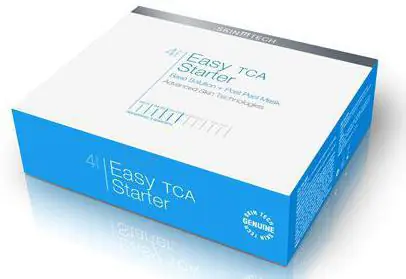
TCA-25 is a solution that must be used when performing a mid-peeling. The duration of exposure of such a product to the skin should not exceed 20 minutes. Otherwise, you may get burned. The composition of trichloroacetic acid is additionally enriched with amino acids. The active component penetrates the skin to the basement membrane, destroying damaged and old cells.
For significant skin rejuvenation, elimination of pronounced wrinkles and long-lasting effect, it is recommended to carry out deep chemical cleansing using 40% trichloroacetic acid. This is a rather painful procedure that not every cosmetologist can perform. Saponins and phytic acid help reduce the aggressive effects of the active substance. The components also accelerate the processes of restoration and regeneration of the epidermis.
Contraindications
Chemical peeling is a fairly serious procedure. Due to the fact that trichloroacetic acid has an aggressive effect on the skin, there are a number of contraindications to cleansing. It is prohibited to check the effectiveness of the method in the following cases:
- in the presence of endocrine pathologies
- during pregnancy and lactation
- in the presence of viral or bacterial diseases
- with increased sensitivity of the dermis and a tendency to allergies
- in the presence of fungal infections of the dermis
- in case of violation of the integrity of the skin
- with severe psychological disorders
- with a tendency to form keloid scars
- for oncological diseases.
The type of peeling is selected by a specialist and depends on the age category.
Preparation
During the process of chemical peeling, the skin is subjected to severe aggressive influence. To prevent the reagent from penetrating into the deep layers of the dermis and damaging them, it is necessary to carry out preliminary preparation. In some cases, it is recommended to start it a month before the cleansing procedure.

First of all, you should stop using scrubs and facial brushes (for several weeks). Cosmetologists also recommend preparatory glycolic peeling. This salon procedure involves cleansing the surface layer of the epidermis and activating metabolic processes in living cells. TCA peeling is applied evenly to clean, smooth skin, which ensures the same depth of action and penetration of the active components.
If you have spider veins, you need to take a course of vascular-strengthening drugs, for example “Rutina”. To prevent the appearance of herpes, it is recommended to start taking Acyclovir tablets 3 days before the procedure.
Immediately before the procedure, the specialist will cleanse the skin of impurities and cosmetics using a low-fat gel. After this, a composition containing trichloroacetic acid is applied.
The price of a TCA chemical peel depends on the concentration of the solution used, the need for pain relief, and the duration of aftercare. For a session with a cosmetologist you will have to pay from 5 to 15 thousand rubles. Further restorative care can be carried out at home.
Trichloroacetic acid: reviews of the peeling procedure
Experienced cosmetologists assure that dry facial cleansing with trichloroacetic acid is a safe and very effective procedure only if it is carried out by a specialist. It is highly not recommended to use this method at home.
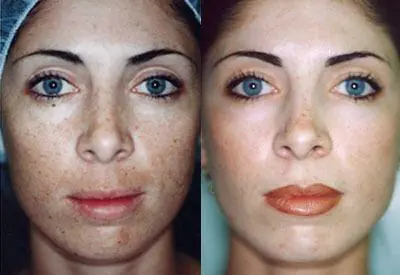
The advantages of TCA peeling include high effectiveness and a short period of further rehabilitation.
The skin, constantly exposed to negative factors - polluted environment, poor diet, frequent stress, bad habits, lack of normal sleep - loses its natural color and elasticity, wrinkles and extraneous rashes appear.
If caring procedures can cope with minor problems, then, for example, with the treatment of freckles, pigmentation, scars and skin unevenness, conventional care products will be ineffective.
Peeling with trichloroacetic acid promises to cope with these and other shortcomings. Let's try to figure it out, is this so?
What is TCA peeling?
TCA peeling is a type of chemical cleansing of the skin with acid, in which the active reagent penetrates into the layers of the dermis, “cutting off” the upper damaged layer.
The effect depends on the depth of exposure and the initial condition of the skin. The procedure requires
- sterile conditions,
- accuracy,
- certain literacy and professionalism.
Classification
For the session, trichloroacetic acid of varying percentage concentrations is used.
According to this, the following types of peeling are distinguished:
Surface (unofficial name TCA 15). To exfoliate the keratinized layers of the epidermis, a 15% solution is used, which is applied for 10–15 minutes.
Median (TSA 25). A 25% reagent is used, which penetrates into the middle layers of the dermis. This species has anti-inflammatory and immunomodulatory effects. It is used only for body skin.
Deep (more than 35%). Due to the high risk of complications, such a solution is used locally to eliminate imperfections in small areas of the dermis (no more than 1 cm).
Mostly superficial and medium peels are performed, but only a doctor can prescribe the required acid percentage for a session.
Properties of trichloroacetic acid
In accordance with the properties of trichloroacetic acid, the process has the following effects:
Regenerative. By acting on the deep layer, the acid increases its proliferation, thereby enhancing the protective properties of the dermis.
Cleansing. This event perfectly cleanses the surface layer of the epidermis. The skin becomes clean and smooth.
Anti-inflammatory: pores narrow, cells secrete less fat.
Stimulating. By undergoing deep peeling, the patient's blood capillaries dilate and metabolic processes accelerate. All this leads to stimulation of collagen production. Effectively used to eliminate problems of inelastic and sagging skin.
Antimicrobial. With the help of acid, all flora that provokes inflammatory processes is destroyed.
Whitening. Helps get rid of freckles, although there are girls who bitterly claim that after peeling with trichloroacetic acid, the pigmentation only intensified.
Indications for the session
This procedure is recommended for:
- small wrinkles
- oily skin
- enlarged pores
- skin stretching due to sudden weight loss, pregnancy
- scar changes
- the appearance of signs of photoaging or age-related changes
- uneven and inelastic dermis
- hyperkeratosis
- high pigmentation and freckles
- the presence of flat birthmarks
- melasach
- dull complexion.
Contraindications
Since peeling is a chemical procedure that has a serious effect on the epidermis, there are a number of contraindications:
- during pregnancy, breastfeeding
- persons under 18 years of age
- for skin lesions at the treatment sites (psoriasis, allergies, herpes)
- signs of a cold
- for hypertension, exacerbations of diseases with chronic forms
- if vitamin A was taken in large doses for six months before the session
- with a predisposition to papillomaviruses and the formation of keloid scars
- no earlier than 2 months after traumatic and deeply acting procedures
- if you are allergic to the sun
- after a fresh tan
- if there are a large number of moles on the body
- during menstruation
- if the client has excess hair growth
- for mental disorders
- if you have sensitive skin.
According to cosmetologists and people who have peeled themselves with trichloroacetic acid, the procedure has a number of advantages:
- Relative safety. The drug used for the procedure, unlike other peeling drugs, does not have a severe toxic effect
- Trichloroacetic acid distributes well over the skin
- Peeling requires minimal preparation
- Completing the activity will not take much time, short rehabilitation period
- Peeling leaves significant visible results
- Determination of clear criteria for the depth of acid penetration.
Flaws
In addition to the revealed advantages, doctors also highlight the disadvantages of the method:
- a large list of contraindications
- since the product quickly penetrates the dermis, this makes it difficult to correctly determine the depth of its action during the session
- pain during the process
- when using a 20–35% acid solution, peeling of the skin appears, which increases the recovery time.
Skin care after the session
Cosmetologists and dermatologists recommend after a peeling session to carry out a set of restorative procedures to increase efficiency.
This complex helps reduce the incidence of side effects and increase the effectiveness of the procedure. It must be performed every day for 2 weeks.
For rehabilitation, the doctor prescribes:
- sunscreen with maximum protection
- antioxidants
- moisturizers
- vitamin and mineral preparations.
What do patients and cosmetologists say?
Many patients complain of skin redness after peeling. With superficial peeling, this symptom can last up to 6 hours. And with medium peeling – up to 5 days. Also, a number of patients experience large peeling of the skin, which lasts for a week.
There are often complaints of mild swelling (for some it is obvious swelling, worse than that of a drunk alcoholic) and high sensitivity. This symptom can last up to 10 days.
There is no clear answer regarding achieving a positive effect after peeling.
- Many people note an improvement in complexion, smoothing out the surface and tone.
- Those who wanted to get rid of scars did not notice any visible results, although they cannot but agree with the statement that the scars fade and become less noticeable.
- Trichloroacetic acid is unlikely to help with pronounced age-related wrinkles, but small, just emerging wrinkles, if they do not disappear, will certainly be smoothed out.
- As for stretch marks, these skin defects are difficult to remove several procedures may be required, and even the fact of their complete disappearance remains in question.
Cosmetologists recommend gentle and medium peelings to almost everyone (Who would doubt that). The best time is autumn-winter. Unlike other “executions,” TCA cosmetic sessions provide excellent results with minimal pain.
Possible complications after the procedure
Peeling with trichloroacetic acid can cause a number of complications:
- exacerbation of papillomaviruses
- scarring
- skin pigmentation disorder
- the appearance of lines on the face between the treated and untreated zones.
So, whether to peel or not to peel is an individual decision for everyone. You can hear many positive reviews about its safety and effectiveness. There is also photo evidence taken before and after peeling. But do not forget that after 35 years the skin’s recovery processes slow down and the risk of complications increases.
If you decide to undergo the procedure, entrust your health and beauty to professionals. And before the event, check your health completely to choose the right type of peeling.
Modern cosmetology widely uses various types of acids. They are actively used in salon treatments and included in professional cosmetics, including creams, lotions and tonics for home use.
Acids are natural components of the skin and are involved in the processes of cellular metabolism and gas exchange. A decrease in the concentration of autogenic acids with age disrupts the normal functioning of cells and becomes one of the factors of aging of the body. Professional procedures and home care replenish their loss and maintain the necessary concentration of substances necessary for the skin. In this case, most often it comes to the use of alpha and beta hydroxy acids.
Carboxylic acids in cosmetology
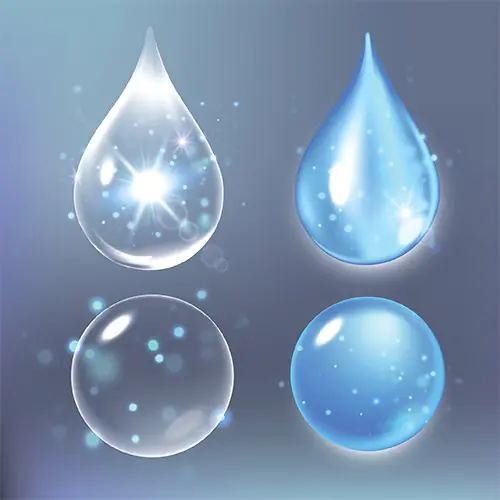
The group of carboxylic acids includes a wide range of weakly acidic substances, united by the content of carboxyl groups in their composition. Due to the variety of properties and characteristics, many of them are successfully used in aesthetic medicine and the production of cosmetic products.
| Types of acids | Example | Properties | Application |
| Fat | |||
| Saturated | Myristic Palmetine Stearic | Emulsifiers, stabilizers | Many varieties of toilet soap are created based on these acids. Acids and their esters are used in the production of cosmetics as emulsion stabilizers. |
| Unsaturated | Linoleic Linolenic Oleic | They replenish the deficiency of epidermal lipids and strengthen the epidermal barrier. By creating a protective film, they prevent the evaporation of moisture from the skin. They are antioxidants. | Included in night and day creams, and in milk for cleansing the skin. |
| Fruit | |||
| Alpha hydroxy acids (AHA acids) | Glycolic Milk Amber Lipoeva Almond Apple Lemon Pyrovinogradnaya and others. | Eliminate hyperkeratosis, create conditions for increasing skin hydration. Stimulates the production of ceramides and collagen fibers. Antioxidant and anti-inflammatory effects. | In concentrations up to 10% they are used in cosmetics: cream, lotion, tonic, incl. for home care. In high concentrations they are used only in salon conditions for exfoliation and superficial peeling. |
| Beta hydroxy acids (BHA acids) | Salicylic | Exfoliates the stratum corneum, reduces sebum production, and removes impurities from pores. Antibacterial, anti-inflammatory effect. | Used for peelings: alone as an exfoliant or as a basis for complex medium peels - Jessner or retinoic. Included in creams, lotions, tonics for oily and problem skin. |
| Polyhydroxy acids (RNA) | Gluconic acid | It has a high molecular weight and has a more gentle effect without causing irritation. Prevents aging, stimulates the production of elastin, increases the protective properties of the skin. Blocks up to 50 percent of UV radiation. | Included in anti-aging skin care programs for hypersensitive skin. |
| Trichloroacetic acid (TSA) | Penetrates deeper into the skin than fruit acids. The principle of action is protein coagulation. | For medium TCA peeling. | |
Fruit AHA acids are water-soluble, and BHAs are fat-soluble. This fundamental difference determines the use of acids in cosmetology. The most famous BHA acid, salicylic acid, penetrates through the lipid barrier deep into the pores, therefore it can act on the sebaceous glands and reduce their excessive activity. Its main purpose is the treatment of acne and blackheads, rejuvenation of oily and problematic skin. AHA acids are more suitable for skin care with photodamage, age spots, age-related hyperkeratosis and dryness. PHA polyacids are prescribed for sensitive skin under stress, with low local immunity.
Glycolic acid in cosmetology
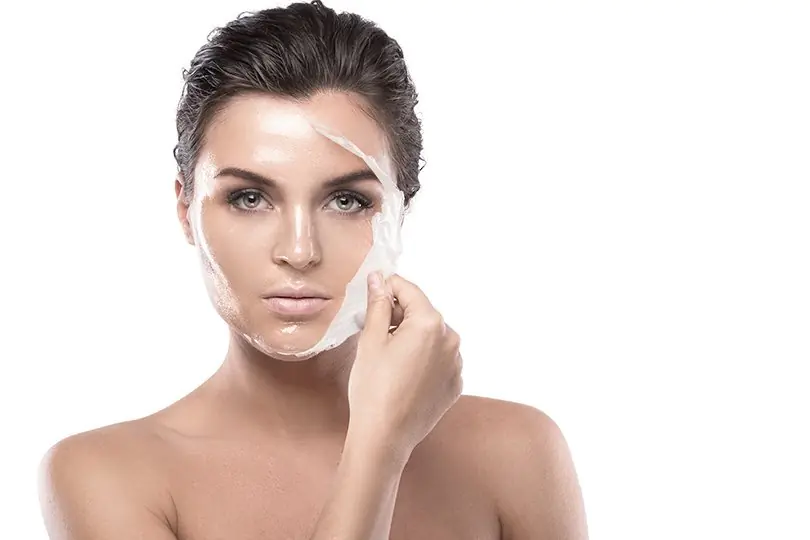
Glycolic acid in cosmetology is the most effective and therefore the most studied of all AHA acids. It gained significant popularity after its ability to activate the synthesis of glycosaminoglycans and collagen in the dermis was proven. An additional advantage of glycolic acid is that it is relatively cheaply produced from sugar cane. Dermatologists at Wakayama Medical University (Japan) have proven the effectiveness of high concentrations of this substance in the treatment of severe forms of acne. Glycolic acid is also successfully used in cosmetology to increase the level of hydration of all layers of the skin.
E.I. Hernandez in his book “Cosmetic Peeling” refers to a number of authoritative studies in cosmetology that describe the use of glycolic acid depending on the concentration:
- Daily care with a cream with 5 percent glycolic acid for three months improves the condition of facial skin. The effects were statistically confirmed by several types of control measurements.
- The hyaluronic acid content of the matrix increases after treating the skin with 20 percent glycolic acid twice daily for three months. Expression of the collagen gene was also recorded, which proves an increase in its synthesis.
- The thickness of the skin, provided that a lotion containing 25 percent glycolic acid is applied to it, increases by 25 percent after six months. Researchers noted an increase in the epidermal layer, an increase in the concentration of mucopolysaccharides, an improvement in collagen density and the state of elastin in the dermis.
- Applying 50% glycolic acid weekly for four weeks significantly improves the quality of skin texture. The stratum corneum decreases and the granular layer of the epidermis increases, and the symptoms of photokeratosis disappear. In a number of cases, biopsies have documented thickening of collagen in the dermis.
Lactic acid in cosmetology
In second place in popularity and study in cosmetology is lactic acid. Just like glycolic, this substance has a good exfoliating effect and helps eliminate signs of chrono- and photoaging. Lactic acid is slightly less effective, but the risk of possible irritation from its use is lower.
Lactic acid is considered more physiological for the skin. Its molecules are one atom larger than glycolic acid molecules, so they penetrate the epidermis more slowly and evenly and destroy intercellular connections. The environment created by lactic acid prevents the development of pathogenic bacteria, increases the hydrolipid mantle and strengthens skin immunity. These properties, along with less aggression, justify the use of lactic acid in cosmetology for patients with sensitive problem skin. Its concentration in home care products ranges from 3.5 to 10 percent.
Succinic acid in cosmetology

In cosmetology, succinic acid is called a life-giving elixir for aging skin. It lightens excess pigment, nourishes and evens out the skin. Succinic acid is a powerful catalyst for the synthesis of adenosine triphosphoric acid (ATP), which plays an important role in cellular metabolism. Due to these properties, succinic acid is included in cosmetology in many anti-aging programs and home care products for aging skin. It is a source of life-giving force for hair.
Lipoic acid in cosmetology
Lipoic acid in cosmetology is not an exfoliant. It is recognized as a powerful antioxidant that suppresses the activity of a wide range of free radicals - a significant cause of skin aging, wrinkles and pigmentation. The high effectiveness of lipoic acid is due to its ability to dissolve in both aqueous and lipid environments, which distinguishes it from many other antioxidant substances, in particular vitamins C and E. At the same time, it does not block their effect, but enhances it.
Lipoic acid (vitamin N) prevents glycation processes, during which collagen fibers combine with glucose molecules and elastin activity decreases. It greatly accelerates glucose metabolism and slows down the deformation of facial skin. With early contact with a cosmetologist and regular use of products with lipoic acid, reversibility of the glycation process and a decrease in signs of age-related changes are observed.
Lipoic acid in cosmetology is also successfully used in the treatment of scars, acne, post-acne and the effects of rosacea. It normalizes the activity of the sebaceous glands, reduces the appearance of skin pores, restores cell membranes and protects DNA from environmental aggression.
Salicylic acid in cosmetology
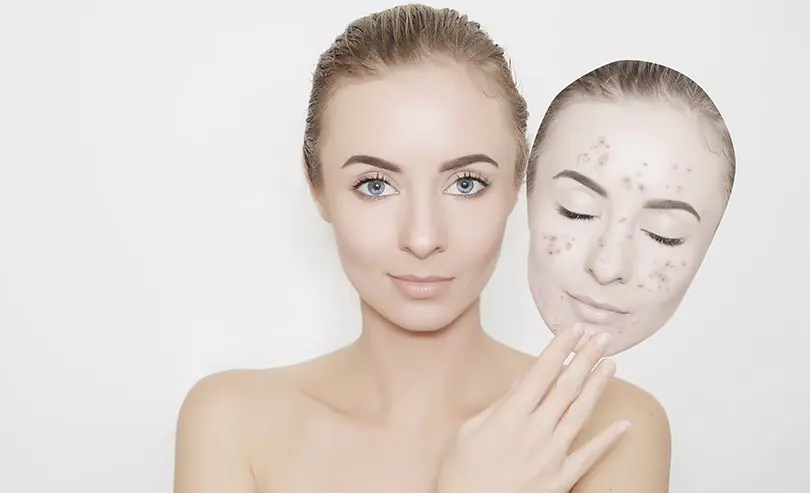
Powerful exfoliation is the main advantage of salicylic acid in cosmetology. This is the most common BHA acid, capable of dissolving connections between horn cells even deep in the pores, i.e. destroy comedones. At the same time, as an aspirin derivative, it reduces inflammation, reduces infectious processes and accelerates healing. The combination of antibacterial properties and deep cleansing effect determine the use of salicylic acid in cosmetology for working with oily problem skin. The concentration of salicylic acid in creams, tonics and lotions for home use should not exceed two percent.
Methods of using acids in cosmetology
First of all, acids in salon cosmetology are used in the form of peelings.
1. Exfoliation and superficial peelings with AHA acids
The connection between hyperkeratosis and many skin diseases was proven back in the 80s of the last century in the first scientific studies on AHA. Removing the dead stratum corneum with acids is considered the safest procedure. A correctly selected concentration of alpha hydroxy acid does not cause skin burns, but delicately destroys desmosomes - strong intercellular connections of keratinized cells.
Later, the ability of AHA acids to penetrate deeper than the stratum corneum and stimulate active processes in the skin was proven. At the same time, due to the dissolution of tight adhesions, microcirculatory beds appear, through which other active substances applied at the final stage of the procedure more easily penetrate into the deeper layers of the skin.
The peeling effect and depth of penetration of the acid depends on its concentration and pH:
- small - 5-10 percent, pH 2-3
- average - 20-30 percent, pH 2-3
- high - 50-70 percent, pH 4-5.
Low concentrations of acids are acceptable for home use, medium and high concentrations are equated to medicines, prescribed only by a cosmetologist for appropriate indications and used for professional procedures in a clinic or salon.
Positive changes from peeling with AHA acids do not occur immediately. For a noticeable effect, 6-10 procedures are required every 7-14 days. However, as a result of the course, the skin has time to completely renew itself without heavy rehabilitation, peeling and serious post-peeling risks.
2. BHA peels
Peels with salicylic acid are widely used to treat acne, scars and post-acne scars, and smooth skin texture. This acid is included in the composition of powerful anti-aging peels, in some cases it is used as a conductor for retinoic acid. Salicylic peeling is a real salvation for people with skin phototypes 4 and 5. Acting as a mild exfoliant, it does not cause post-peeling complications in dark-skinned people.
3. Medium acid peels
The mechanism of action of hydroacids does not allow them to penetrate into the middle layer of the epidermis even with increasing concentration. Therefore, other types of acids are used for deeper skin renewal. Trichloroacetic acid (TCA) coagulates proteins, causing a controlled chemical burn. During the recovery process, active regeneration and proliferation of cells of both the epidermis and dermis occurs. Pure retinoic acid, a derivative of vitamin A, interacts with fibroblasts during the peeling process, increases their activity and thus enhances the synthesis of elastin, collagen and hyaluronic acid.
Cosmetics with acids
Low concentrations of acids are included in complexes of professional aesthetic care and home cosmetics. Regular use of such products causes a softer but lasting result.
Due to their nutritional properties, fatty acids often become the basis for thick creams. Amino acids - components of proteins - are important for the production of active components of the dermal matrix and are suitable for all skin types. Weak forms of retinoic acid contain creams and serums for rejuvenation, acne, rosacea and dermatitis.
Hydroxy acids are useful at any age and are included in the formulations of creams, lotions, tonics and serums. Salicylic acid is most often found in cosmetics for teenagers, for oily and problem skin.
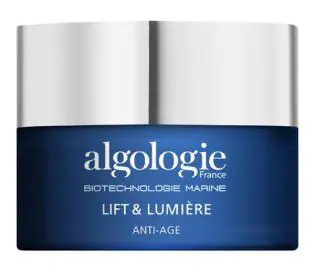
Regular exfoliation after 40 is a necessary condition for age-related care. A prerequisite for using preparations with hydroacids is protection from solar radiation, which is why many of them contain UV filters.
Products even with a low acid content are recommended to be used under medical supervision. It is easier to purchase them from the cosmetologist who draws up aesthetic correction programs. Many professional preparations can be used both in the salon and at home, so it will be more convenient to control the flow of acids into the skin.



